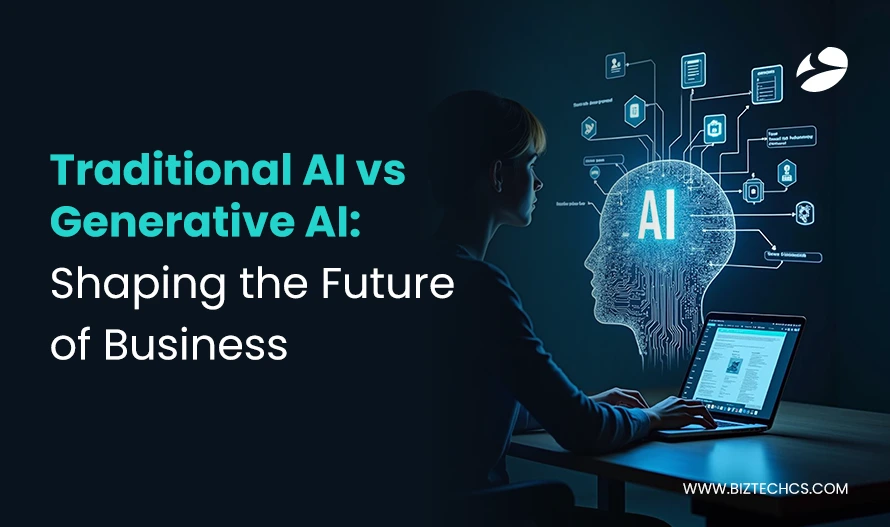Traditional AI vs. Generative AI: A Detailed Comparison
09 May, 2025
10 min read
09 May, 2025
10 min read
Table Of Content

Artificial Intelligence (AI) has been around for some time now, impacting industries including search engines, fraud detection, and voice assistants. More recently, AI is top of mind, in large part due to Generative AI. Out of nowhere, possibilities appear endless: creating content, answering questions, and automating tasks in ways we couldn’t see before.
In this blog, we’ll explore the differences between Traditional AI and Generative AI. What makes them unique? How do they work, and how can they be applied to real-world problems?
Let’s break it down.
Traditional AI, referred to as “narrow AI” or “weak AI,” consists of systems developed to solve specific tasks using rules and algorithms. There are no advancements or new outcomes from traditional AI; it simply uses rules and applies those rules to data to develop predictions or make decisions.
For example, a chess AI looks at the board and uses different strategies to guess the next moves. It is beneficial in completing focused tasks, but it can’t think beyond those parameters. Traditional AI has been successfully employed in medical diagnosis, chatbot customer service, and predictive maintenance.
Generative Artificial Intelligence can be defined as a category of AI that can create new content (text, images, or even video) based on the data it has been trained on. Whereas traditional AI always followed rules, generative AI, through machine learning, is able to identify patterns in data and create unique outputs based on those patterns.
For example, ChatGPT-like models can produce text based on prompts, while other generative AI models such as Pika Art can produce art, music, or video. Because generative AI development services depend on large datasets and human input to drive the output, they are increasingly in demand, enabling businesses to build custom solutions that generate original, context-aware content across formats.
Generative AI has many advantages over standard AI regarding creativity, flexibility, and personalization. Here are a few factors:
In summary, generative AI (the ability to produce original content) can produce experiences unique to situations, experiences, and ultimately users, outperforming traditional models.
|
Sr. No |
Basis of Comparison | Generative AI |
Traditional AI |
|
1 |
Scope |
Broader scope, designed to create new, original content based on inputs. | More focused scope, primarily used for analyzing and processing existing data. |
|
2 |
Methodology |
Relies on complex deep learning models like GANs and transformers. | Uses simpler machine learning models like decision trees, linear regression, etc. |
|
3 |
Data Requirements |
Operates with unstructured data and can create new content based on patterns. | Requires large volumes of structured, labeled data for training and predictions. |
|
4 |
Creativity |
Can generate creative content such as text, images, music, etc. | Does not generate new content; focused on applying existing knowledge to tasks. |
|
5 |
Application areas |
Content creation (e.g., writing, art, music), personalization, and creative tasks. | Data analysis, fraud detection, recommendation systems, predictive modeling. |
|
6 |
Learning process |
Learns from large, diverse datasets and can create novel outputs. | Learns from structured datasets and predicts or categorizes based on past patterns. |
|
7 |
Complexity |
More complex, requiring significant computational power and advanced algorithms. | Less complex, focuses on structured problem-solving with predefined rules. |
|
8 |
Flexibility |
Highly adaptable, capable of creating content across various domains. | Less flexible, designed for specific tasks like classification or prediction. |
|
10 |
Transparency |
It can be less transparent due to the complexity of its learning processes. | More transparent, as the decision-making process follows predefined rules. |
|
11 |
Outcome |
Generates new, original content. | Provides predictions or classifications based on existing data. |
|
12 |
Use in automation |
Useful in tasks requiring creativity or new content generation. | Excellent for automating routine, predictable tasks where accuracy is key. |
|
13 |
Limitations |
Can be unpredictable and biased based on the training data. | Limited by the scope of the training data and struggles with unstructured data. |
In summary, generative AI and traditional AI both present particular advantages.
Traditional AI is specifically designed to correctly complete tasks such as analyzing data or automating tasks with high reliability and accuracy. Generative AI is best at creating new content, which lends itself to exciting business opportunities in areas such as marketing and design.
In the future, these two AI technologies will likely blend, with each technology offering its own strengths. Knowing when to use one or the other should enable businesses to take advantage of both of these able AI technologies.
For teams exploring practical uses of content generation, Biztech’s generative AI development services can help turn ideas into solutions.
Generative AI and machine learning have distinct focuses. Machine learning examines data to create forecasts, while generative AI creates new content based on learned patterns. The choice depends on the work: machine learning for forecasts, generative AI for content.
Generative AI and traditional AI both rely on data input to accomplish tasks. Traditional AI holds to pre-defined, established rules (guidelines) and is limited to accomplishing specific tasks and actions. Gen AI provides the ability to create new content and solves problems more flexibly and creatively.
Generative AI differs in that it creates new content, such as text, images, or music. In contrast, traditional AI focuses on tasks like data analysis and decision-making based on predefined rules. Generative AI offers greater creativity and adaptability, producing original outputs rather than merely analyzing data.
Generative AI is used in content creation (writing, music, art), AI chatbots, and personalized recommendations. Traditional AI is commonly found in spam filtering, as well as banking fraud detection and predictive maintenance. It uses rules-based processes to review data and make decisions.
Generative AI requires large datasets since it generates new content based on patterns it uses when producing anything new. Traditional AI relies on more structured data and focuses on specific tasks. Traditional AI must have high-quality and accurate data to function and be constructive within its designated use.

Artificial Intelligence (AI)
28
By Uttam Jain
19 Dec, 2025

Artificial Intelligence (AI)
112
By Uttam Jain
10 Dec, 2025

Artificial Intelligence (AI)
199
By Afzal Qureshi
09 Dec, 2025